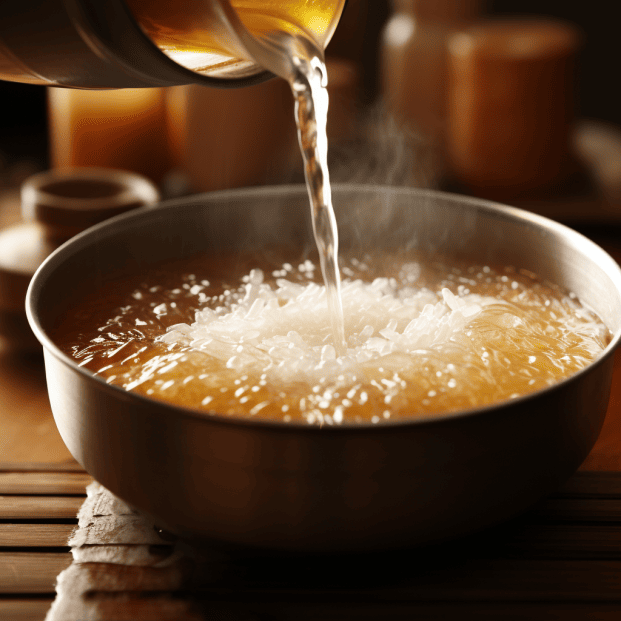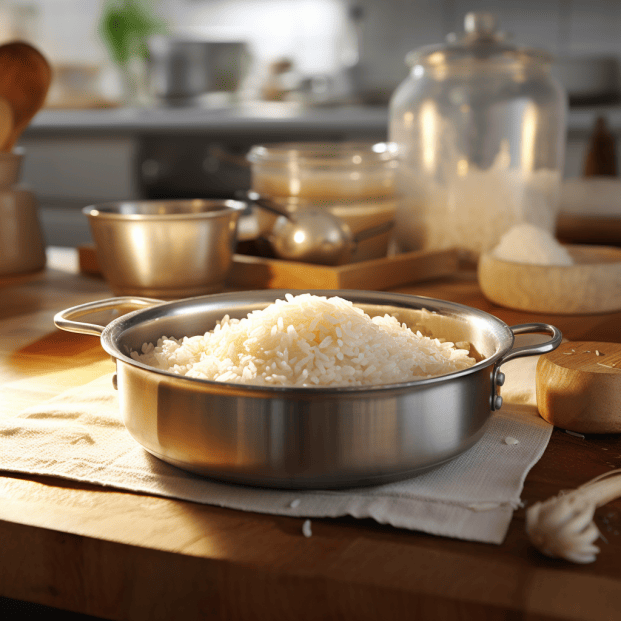Do Asians soak rice before cooking?
While you may think simply washing and boiling rice is enough, many Asian chefs will tell you soaking is a secret technique for taking your rice to the next level.
So, are you curious about rice soaking in Asian cuisine?
As someone who has traveled throughout Asia sampling their delicious foods, I’ve learned a thing or two about how to perfectly prepare rice.
The practice of soaking rice before cooking has been passed down through generations, and for good reason.
When done properly, it allows the rice grains to become more plump and tender, resulting in fluffier individual pieces of rice.
I first witnessed the power of soaking rice years ago during a trip to Thailand.
Upon seeing my interest in their culinary traditions, a local family invited me into their home to observe their cooking process.
What struck me most was how attentive they were when soaking their jasmine rice.
They submerged the grains in fresh water for at least 30 minutes, even periodically rubbing the rice between their hands.
The results were unbelievable – each grain remained distinct and never stuck together.
Since then, I have tested soaking methods with different types of rice across Asia with consistently excellent outcomes.
In this guide, I’ll share the exact techniques used by professionals for soaking a variety of rices, from jasmine to sticky varieties.
I’ll also reveal how long you should soak to get spa-like treatment levels of tenderness and flavor.
By learning the art of rice soaking, your bowls will soon rival that of any Asian restaurant.
So keep reading to unlock the secrets of perfect Asian rice!
KEY TAKEAWAY
Do Asians soak rice before cooking?
Yes, many Asians soak rice before cooking it. (1)
This practice is common across Asian cuisines as it helps improve the rice’s texture, taste, and overall quality, making it fluffier and easier to cook.
Is Soaking Rice Before Cooking Standard in Asian Cuisine?
You betcha soaking rice is totally normal in Asian cooking! I’ve explored all kinds of Asian cuisines during my travels and seen first-hand how soaking rice is key.
This trick’s been passed down for generations ’cause it really works.
When rice gets a good soak, it comes out fluffier and less sticky once cooked.
The water washes away extra starch from the grains, so they don’t get gloppy and clumped together.
A quick 30-minute soak is all it takes to get that light, tender texture Asian dishes are famous for.
Soaking also lets the rice absorb some moisture ahead of time.
This super-charges the cooking so the grains get done faster.
Less cook time but still perfectly fluffy rice? Now that’s a win-win, baby!
Here’s another perk – soaking boosts nutrients like iron and zinc in rice, studies show.
That makes the rice healthier for ya!
So next time you whip up some Asian cuisine, don’t forget to give that rice a relaxing soak.
Your taste buds will thank you!
What are the Purported Benefits of Soaking Rice?

Rice soaking isn’t just an old wives’ tale – this simple step packs some legit benefits! (2)
Let me break down why taking the time to soak your rice is 100% worth it:
Fluffier, lighter rice: Soaking lets each grain absorb water and expand a bit. This makes the rice nice and puffy after cooking instead of dense.
Less stickiness: Soaking also washes away extra starch from the surface. No more clumpy, gloopy grains!
Faster cooking: Since the rice has already soaked up some liquid, it cooks up speedier. Got a hankering for rice but don’t want to wait forever? Soaking’s got your back!
More nutrients: Soaking activates enzymes that make nutrients like protein and carbs easier to absorb. So your body gets more nutritional bang from the rice.
Better taste: Hydrated rice just tastes better – sweeter and more fragrant. That moisture gets evenly distributed while cooking, amping up the flavor.
Even cooking: With water absorbed evenly, every grain cooks perfectly from edge to edge. No under or overcooked portions in sight!
When you take the time to soak rice beforehand, your patience pays off with better texture, faster cooking, and bonus nutrition. That’s what I call rice Zen!
Which Rice Varieties Benefit Most From Soaking?

If you wanna unlock the full powers of rice soaking, it helps to know which varieties thrive with a good soak.
After tasting my way through tons of Asian rice dishes, here’s my handy guide:
Long-grain white rice is a top soaker. A pre-cook bath washes away excess starch so the grains stay nice and separate for fried rice and stir-fries. No gummy clumps here!
Basmati rice also loves a good long soak – I’m talking at least 2 hours. This helps the grains absorb water evenly and cook up super fluffy, with that irresistible aroma intact.
Brown rice benefits big time from an overnight soak. This radically reduces the cook time but still gives you tender grains. Way faster than boiling for like, a year!
Sticky or glutinous rice does best with a quick 30-minute soak. This keeps it nice and sticky but washes away just enough starch for fluffier texture.
The exact soak time depends on the variety and your taste.
But taking the time to soak your rice will reward you with better flavor and texture every time!
How Long Should You Soak Rice to Maximize Results
Finding the perfect soaking time for rice takes some experimenting.
But after making enough inedible rice bricks to build a house, I’ve cracked the code. Here are my top tips:
1. Consider the variety. Short-grain rice likes quicker soaks while long-grain needs more time. Basmati can soak for a few hours!
2. Think about texture. You want tender, pillowy grains? Soak longer. Prefer some bite? Soak less.
3. Temperature matters. Warm water helps rice absorb faster, shortening soak time. Cold water means plan for a longer bath.
4. Personal taste rules. Cooked until super soft or with some bite left? Your preference determines duration.
5. When in doubt, wait it out. Can’t hurt to soak a bit longer! No one likes crunchy
Does Soaking Rice Improve Nutrition and Digestibility
You betcha soaking rice before cooking makes it way more nutritious and easier to digest.
After tasting rice prepared all kinds of ways during my adventures in Asia, I picked up some insider tricks.
Here’s the scoop on why taking the time to soak your rice pays off big time:
Soaking breaks down phytic acid in rice.
This is a sneaky molecule that binds to important minerals like iron, calcium and zinc.
Soaking sets these minerals free, so your body can actually absorb them! Pretty cool how a simple soak unlocks more nutrition.
Soaking also softens up the outside of the rice grains.
This makes it a piece of cake for your digestive enzymes to break down the carbs inside.
Soaked rice won’t lead to that uncomfortable bloated feeling – your tummy will thank you!
I don’t know about you, but I’m sold on soaking! This easy step helps you get way more nutritional bang for your rice buck.
Your body will be able to use all those nutritious minerals that normally go to waste.
And who couldn’t use an easier time digesting? Soaking rice for the win!
What is the Best Way to Wash Rice Before or After Soaking
Getting rice squeaky clean before cooking is mega important. Here are my tried and true steps for perfectly washed rice:
Step 1: Measure out the exact amount of rice you’ll need according to your recipe. No more, no less!
Step 2: Rinse those grains under cold water. Gently rub them between your fingers to loosen any dirt or debris.
Step 3 (optional): Let that rinsed rice soak for 30 minutes up to a few hours. This helps achieve fluffy perfection!
Step 4: Drain off all the water, whether you soaked or not. Dump that starchy water down the drain.
Washing before soaking helps get rid of any lingering dirt. The soak then targets excess starch for fluffy, separated grains.
Just be sure to drain after!
With these simple steps, you’ll have clean, refreshed rice ready to transform into a delicious and nutritious meal.
Perfect rice, here we come!
When is Soaking Rice Unnecessary for Making Great Rice?
While soaking rice can really amp up the taste and texture, you can still make fantastic rice without this extra step.
Soaking isn’t always needed to whip up a mouthwatering rice dish!
Here’s the scoop on when it’s A-OK to skip the soak:
Modern Rice: Thanks to new milling methods, today’s rice has less starch on the surface. Less need to soak away excess!
Certain Varieties: Short-grain sticky rice for sushi is naturally sticky – no soak required. The water absorption during cooking is enough.
Careful Cooking: With precise timing and water ratios, you can cook rice to tender perfection without soaking.
Mushy Risk: Soaking too long can lead to mushy, overcooked rice. No soak means less things to monitor!
While soaking has some benefits, don’t sweat it if you don’t have time.
As long as you wash the rice, use good cooking techniques, and pick the right rice variety and Chinese products, you can still achieve restaurant-worthy results without this extra step!
Conclusion
In conclusion, as an avid lover of Asian cuisine, I can confidently say that soaking rice before cooking is indeed a standard practice.
The benefits of this culinary alchemy are numerous – it helps to remove excess starch, enhances the texture and flavor of the rice, and ensures even cooking.
Certain varieties like basmati and jasmine rice greatly benefit from soaking, resulting in fluffy and fragrant grains.
To maximize the results, it is recommended to soak rice before steaming for at least 30 minutes.
Not only does soaking improve digestibility, but it also increases nutrient availability.
For optimal results, rinse the rice before soaking to remove any impurities.
However, there are instances when soaking may not be necessary; for example, when using quick-cooking or pre-cooked rice varieties.
So next time you embark on your culinary adventures with Asian cuisine, don’t forget to indulge in this age-old tradition of soaking rice for a truly magical dining experience.
References
- https://www.abc.net.au/everyday/do-you-need-to-wash-rice-before-cooking-it/100538794#:~:text=%22%5BBasmati%5D%20rice%2C%20that,for%20the%20rice%20to%20expand.%22
- https://www.newmalaysiankitchen.com/why-you-should-soak-grains-like-rice-before-cooking-how-to-activate-your-grains/
Related Articles
- https://bowlakechinese.com/steaming/
- https://bowlakechinese.com/low-sodium-chinese-food-products/
- https://bowlakechinese.com/why-do-asians-clean-their-rice/
Was this helpful?

I am a skilled chef assistant with a passion for Asian cuisine, I have honed my craft through formal training at At-Sunrice GlobalChef Academy and years of experience in the culinary industry. I have extensive knowledge of cooking techniques and herbs and spices, with a particular focus on traditional Chinese dishes. I’m also an author of the book “Delicious Keto Low Carb Chinese Food for Busy Moms and Fitness Enthusiasts” which is sold on Amazon. On my blog, bowlakechinese.com, I share my expertise in Asian cuisine and provide tips and recipes for those interested in low carb Chinese cuisine.

